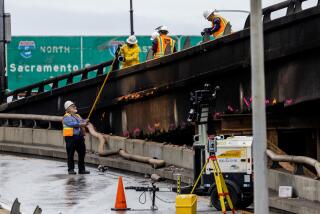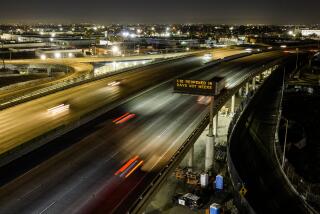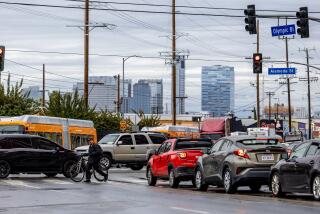Traffic jam near Beijing stretches on for days
- Share via
Reporting from Beijing — Talk about a four-lane highway turning into a parking lot.
For more than nine days, for more than 60 miles, thousands of Beijing-bound vehicles have come to a virtual standstill on stretches of highways called the 6 and 110 (honest!) that run from Inner Mongolia southeast to the nation’s capital.
Bai Xiaolong, a 30-year-old truck driver, says it took him five days to make the 350-mile journey from Inner Mongolia to Tianjin, a port city east of Beijing. He spent much of that time reading, text-messaging and sleeping rather than accelerating, he said.
“There was one day that I didn’t move, not even an inch,” said Bai, a resident of Jining in Inner Mongolia, a city at the western end of the traffic jam.
Chinese officials quoted in the state news media attribute the epic congestion primarily to maintenance projects that began in mid-August and are not scheduled for completion until mid-September. Trucks carrying 8 tons or more of coal or fruit have been responsible for damaging the roadway, officials said, thus necessitating the work.
Motorists who regularly use the route counter that heavy traffic has long been a fact of life.
“The problem is really that there are too many cars and trucks and not enough lanes,” Bai said. “We drivers are accustomed to this sort of thing happening.”
The two national expressways are heavily traveled by trucks carrying coal from recently opened fields of Inner Mongolia to China’s booming coastal cities. Coal provides the majority of the nation’s energy, as well as a large portion of its notorious air pollution.
The seemingly endless jam began on the 6 and spread to the 110, which runs parallel, when officials sought to ease the traffic on the 6.
The Global Times, an English-language newspaper with ties to the Communist Party, said the jam had eased somewhat in the last two days, but residents of the region say the congestion simply spilled out onto other roads.
The tie-up has created an economy of its own. Vendors sell boxed lunches, ramen noodles and drinking water to the captive audience, often at jacked-up prices. Roving gangs reportedly have preyed on fatigued motorists, siphoning gasoline as they snooze.
And because of the long-standing problems along the highways, dozens of small hotels have cropped up, catering to drivers who seek a respite to catch more serious sleep.
“Business is good,” said Li Chenli, a 40-year-old receptionist at a hotel in Xinghe, a stop along the route. “But we don’t like the traffic jam. It’s hard for relatives to come to visit. Life is inconvenient. Wherever you go, you’re just waiting and waiting.”
Traffic is an increasing frustration in China, which has become the world’s largest market for new cars. In 2009, sales rose 45%. According to one traffic official, the number of cars on the road in Beijing increases by 1,900 a day.
At this point, the average speed of a car during morning commuting hours in the capital is 14.5 mph and is expected to drop to 9 mph by 2015, according to figures released Tuesday by the Beijing Transportation Research Center to the state news media.
In contrast, regional planners in Los Angeles say sensors buried under the pavement show an average rush-hour speed of about 20 mph.
Beijing officials seeking to cope are experimenting with staggered work hours and restrictions on the number of days each car is permitted on the roads.
The Chinese are also developing what they call a “super bus,” which would straddle two lanes of traffic, and allow cars to drive underneath from back to front while as many as 1,400 commuters ride above. The bus, which would require some sort of elevated stops to enable passengers to get on and off, is expected to be tested for the first time in coming months.
barbara.demick@latimes.com
Tommy Yang in The Times’ Beijing Bureau contributed to this report.
More to Read
Sign up for Essential California
The most important California stories and recommendations in your inbox every morning.
You may occasionally receive promotional content from the Los Angeles Times.













